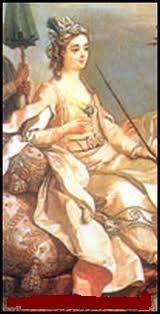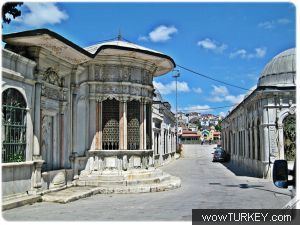Name Mihrisah Sultan Religion Sunni Islam Predecessor Sehsuvar Sultan | Spouse Mustafa III (m. ?–1774) Role Mustafa III's wife Children Selim III | |
 | ||
Tenure 7 April 1789 – 16 October 1805 Died October 16, 1805, Constantinople Place of burial Eyüp, Istanbul, Turkey Successor Ayse Seniyeperver Sultan Similar People Selim III, Mustafa III, Ahmed III | ||
Mihrişah Sultan (also spelled Mihr-i Şāh; c. 1745 – 16 October 1805), known as "the Georgian Beauty", was the consort to Ottoman Sultan Mustafa III, and the mother of Sultan Selim III and his de facto co-regent (as the Valide Sultan) for sixteen years from 1789 until 1805.
Contents
Mihrişah’s Early Years
In 1757, Mihrişah was given as a gift to Sultan Mustafa III and was added to his harem. She soon gained the Sultan’s favor and was made a consort of the sultan.
In 1759, she gave birth to a daughter named Hibetullah Sultan. Hibetullah’s birth was greatly celebrated, as she was the first child born to the imperial family in 30 years.
Two years later, in 1761, she gave birth to a son, named Şehzade Selim (the future Sultan Selim III). The celebrations surrounding Selim’s birth continued for seven days and seven nights. Mihrişah had given birth to the first son and heir in the imperial family in over 30 years. Because of this, Mihrişah became Sultan Mustafa III’s BaşKadin, meaning “first consort”.
Mihrişah had one more daughter in 1770, named Fatma Sultan. Unfortunately, Fatma Sultan died just two years after her birth.
In 1774, Mihrişah was widowed following the death of her husband, Sultan Mustafa III. The sultan’s brother, Abdul Hamid, became the next sultan. Mihrişah was sent to live at the Eski Saray (the Old Palace). Her son, Şehzade Selim, was confined in the Topkapı Palace.
Life

Of ethnic Georgian origin, she was the daughter of a Georgian Orthodox priest. Her given name is believed to have been Agnès (Georgian: აგნესა/Agnesa). She was beautiful, and was called "the Georgian Beauty" (Turkish: Gürcü güzeli). She received the name Mihr-î-Şah, meaning "Sun of the king".
She is described as a willing protagonist of the reforms of her son's reign. She was especially preoccupied in reforming the military schools and establishing diplomatic corps. She occasionly approached her son to beg a favour or an act of mercy. She founded many schools and mosques in the 1790s. In 1795, she founded the Mihrişah Valide Sultan School and Külliye in the region of Eyüp in Istanbul. In 1805, she ordered the construction of the Mihrişah Valide Sultan Fountain in Yeniköy in İstanbul. The imaret, which was built by the order of Mihrişah, is still in working order. She was the subject of a poem. Mihrişah Valide Sultan and her son Selim III were both members of the Mevlevi Order, which practiced Sufi whirling.
Mihrişah As Vâlide Sultan
When Sultan Abdul Hamid died in 1789, Mihrişah’s son became the next sultan of the Ottoman Empire, and she became Vâlide Sultan. The word vâlide means “mother” in Ottoman Turkish (Arabic: wālida). Vâlide Sultan is the title held by the mother of a ruling Sultan of the Ottoman Empire.
Sultan Selim III was young when he became ruler of the Ottoman Empire, so he relied heavily on Mihrişah Vâlide Sultan for advice and guidance. The sultan was very fond of his mother and extensively renovated her quarters in the Harem circle of the Topkapı Palace just for her. It was rumored that Sultan Selim III would go to her apartments daily and discuss city issues.
Though she had the full affection of her son, Mihrişah Vâlide Sultan never took advantage of that and didn’t interfere with the social and political affairs of the state. She cared about her son and was particularly concerned about his nervous and anxious nature. She tried to shelter him from unpleasant news, like the French invasion of the Ottoman territories of Egypt and Syria by Napoleon in 1798.
Mihrişah Vâlide Sultan’s Dam
Apart from the mosques and schools Mihrişah Vâlide Sultan had built, she also ordered the construction of the Vâlide Dam.
Constantinople (Istanbul) was often short on water. This problem was addressed by building “bends” in rivers to collect water and transport them to fountains or kiosks, where free drinking water was provided to the people. Members of the dynasty, especially the sultans, would construct these “bends” as an act of charity and to gain favor from God.
Mihrişah Vâlide Sultan ordered the construction of one of these “bends” from her own budget to gain charity. It was later named after her and was called Mihrişah Vâlide Sultan Bendi, or the Vâlide Dam.
